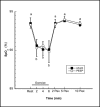Extrinsic Threshold PEEP Reduces Post-exercise Dyspnea in COPD Patients: A Placebo-controlled, Double-blind Cross-over Study
- PMID: 21886475
- PMCID: PMC3163412
Extrinsic Threshold PEEP Reduces Post-exercise Dyspnea in COPD Patients: A Placebo-controlled, Double-blind Cross-over Study
Abstract
Purpose: Most patients with chronic obstructive pulmonary disease (COPD) complain of dyspnea during and following exercise, and the development of intrinsic positive end-expiratory pressure (PEEP) is thought to contribute to lung hyperinflation and dyspnea. Many people with COPD use pursed lip breathing (PLB) in an attempt to produce extrinsic PEEP to reduce lung hyperinflation and dyspnea during and following exertion. We hypothesized that the use of a threshold, extrinsic PEEP device would reduce post-exercise dyspnea in people with COPD.
Methods: A double blind, crossover study was conducted on post-exercise dyspnea in 8 patients with COPD whose exercise tolerance was limited by dyspnea. Subjects performed two identical 6-minute treadmill bouts that led to a Borg dyspnea rating of at least 5/10. Dyspnea, heart rate, and oxygen-hemoglobin saturation (SpO(2)) were recorded at rest, every 2 minutes during exercise and at 2, 5, and 10 minutes post-exercise. Immediately following the exercise bouts, the subjects used either a threshold PEEP device for 6 breaths at 10 cm H(2)O or a Sham device.
Results: Heart rate and SpO(2) were not different between treatments any time point before, during, or after exercise. Dyspnea ratings were not different between devices at rest or during exercise, but were lower in the post-exercise period following use of PEEP (p < 0.05). When asked which device, if any, the subjects would prefer to use to relieve post-exercise dyspnea, 7 of 8 chose the PEEP device and one had no preference.
Conclusions: We found that the use of a PEEP device can help reduce postexercise dyspnea in patients with COPD.
Keywords: COPD; PEEP; dyspnea; exertion; pursed lip breathing.
Figures



Similar articles
-
Positive expiratory pressure breathing speeds recovery of postexercise dyspnea in chronic obstructive pulmonary disease.Physiother Res Int. 2019 Jan;24(1):e1750. doi: 10.1002/pri.1750. Epub 2018 Sep 24. Physiother Res Int. 2019. PMID: 30251299 Clinical Trial.
-
Pursed lip breathing improves exercise tolerance in COPD: a randomized crossover study.Eur J Phys Rehabil Med. 2015 Feb;51(1):79-88. Epub 2014 Apr 2. Eur J Phys Rehabil Med. 2015. PMID: 24691248 Clinical Trial.
-
Factors discriminating spontaneous pursed-lips breathing use in patients with COPD.COPD. 2010 Aug;7(4):254-61. doi: 10.3109/15412555.2010.496820. COPD. 2010. PMID: 20673034
-
Tiotropium bromide. A review of its use as maintenance therapy in patients with COPD.Treat Respir Med. 2004;3(4):247-68. doi: 10.2165/00151829-200403040-00005. Treat Respir Med. 2004. PMID: 15350163 Review.
-
Management of dyspnea in severe chronic obstructive pulmonary disease.J Pain Symptom Manage. 2000 May;19(5):378-92. doi: 10.1016/s0885-3924(00)00129-9. J Pain Symptom Manage. 2000. PMID: 10869878 Review.
Cited by
-
Benefits of Whole-Body Vibration, as a Component of the Pulmonary Rehabilitation, in Patients with Chronic Obstructive Pulmonary Disease: A Narrative Review with a Suitable Approach.Evid Based Complement Alternat Med. 2016;2016:2560710. doi: 10.1155/2016/2560710. Epub 2016 Apr 14. Evid Based Complement Alternat Med. 2016. PMID: 27190529 Free PMC article. Review.
-
Efficacy and safety of long-term use of a positive expiratory pressure device in chronic obstructive pulmonary disease patients, a randomized controlled trial.BMC Pulm Med. 2023 Jan 16;23(1):17. doi: 10.1186/s12890-023-02319-5. BMC Pulm Med. 2023. PMID: 36647057 Free PMC article. Clinical Trial.
-
Whole-body vibration as a mode of dyspnoea free physical activity: a community-based proof-of-concept trial.BMC Res Notes. 2013 Nov 11;6:452. doi: 10.1186/1756-0500-6-452. BMC Res Notes. 2013. PMID: 24209408 Free PMC article. Clinical Trial.
-
Influence of conical-PEP breathing on exercise performance in patients with chronic obstructive pulmonary disease: A single-blind randomized crossover trial.Can J Respir Ther. 2025 Jun 16;61:132-144. doi: 10.29390/001c.138738. eCollection 2025. Can J Respir Ther. 2025. PMID: 40547358 Free PMC article.
-
Effects of breathing maneuver and sitting posture on muscle activity in inspiratory accessory muscles in patients with chronic obstructive pulmonary disease.Multidiscip Respir Med. 2012 Jun 20;7(1):9. doi: 10.1186/2049-6958-7-9. Multidiscip Respir Med. 2012. PMID: 22958459 Free PMC article.
References
-
- Rochester CL. Exercise training in chronic obstructive pulmonary disease. J Rehabil Res Dev. 2003;40:59–80. - PubMed
-
- Grazzini M, Stendardi L, Gigliotti F, et al. Pathophysiology of exercise dyspnea in healthy subjects and in patients with chronic obstructive pulmonary disease (COPD) Respir Med. 2005;99:1403–1412. - PubMed
-
- Hoo GW. Nonpharmacologic adjuncts to training during pulmonary rehabilitation: the role of supplemental oxygen and noninvasive ventilation. J Rehabil Res Dev. 2003;40:81–97. - PubMed
-
- O'Donnell DE, Lam M, Webb KA. Measurement of symptoms, lung hyperinflation, and endurance during exercise in chronic obstructive pulmonary disease. Am J Respir Crit Care Med. 1998;158:1557–1565. - PubMed
-
- O'Donnell DE, Lam M, Webb KA. Spirometric correlates of improvement in exercise performance after anticholinergic therapy in chronic obstructive pulmonary disease. Am J Respir Crit Care Med. 1999;160:542–549. - PubMed
LinkOut - more resources
Full Text Sources
